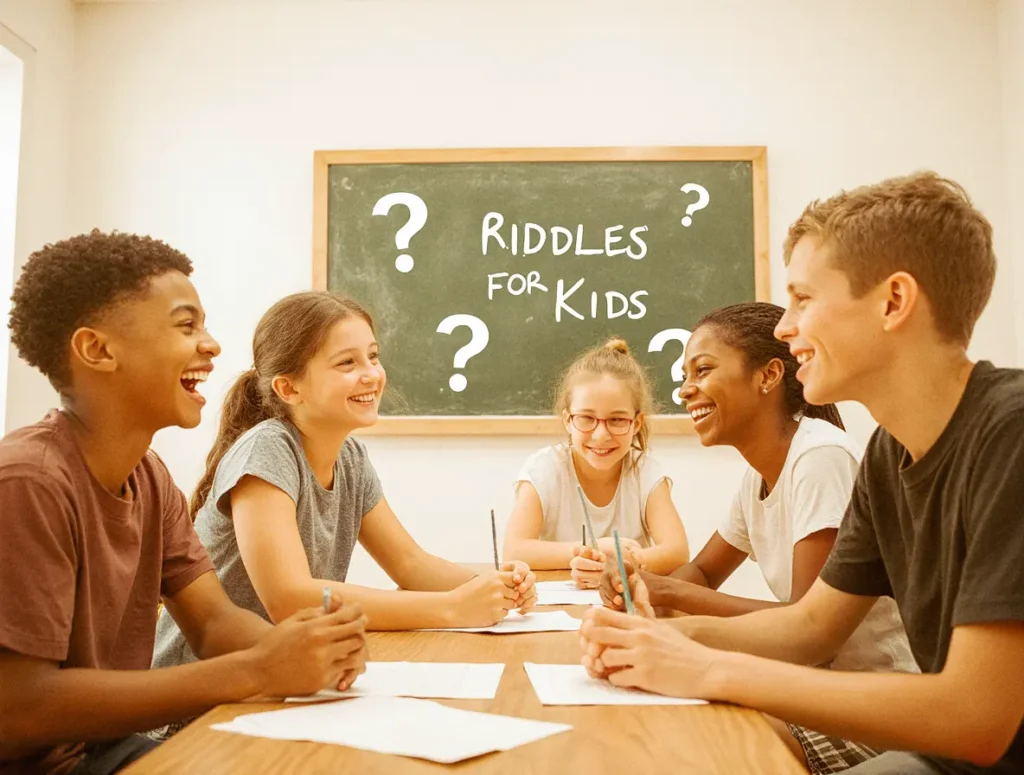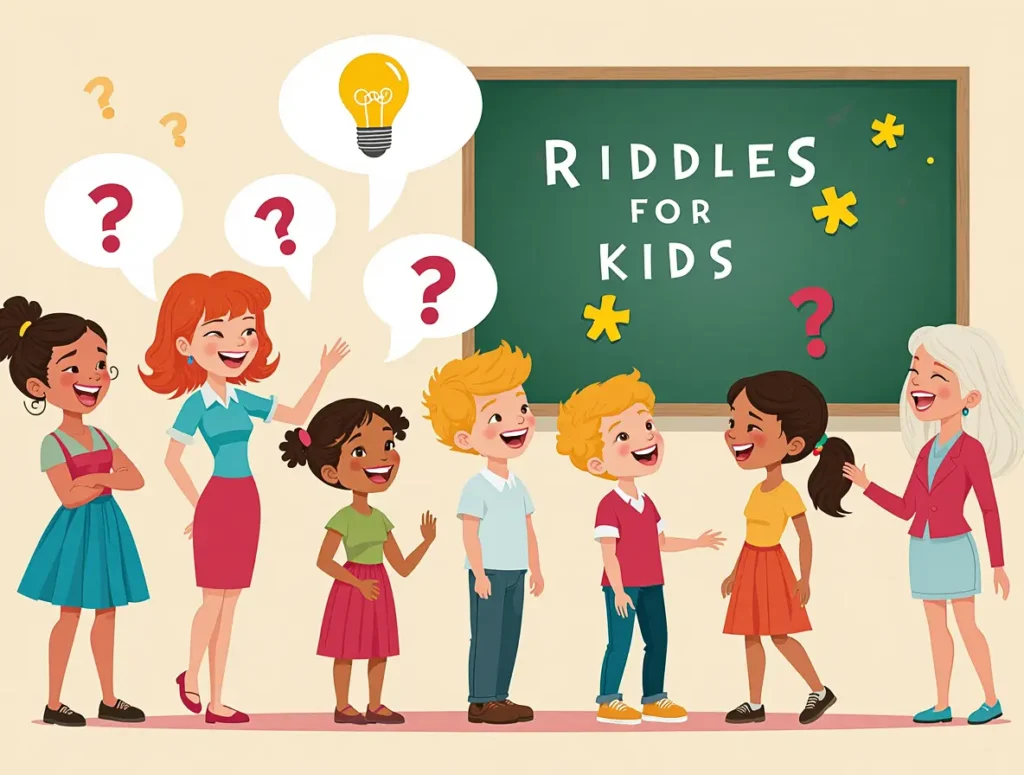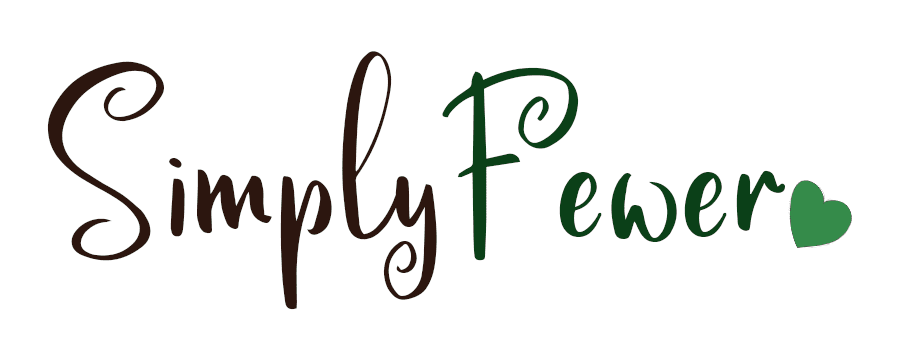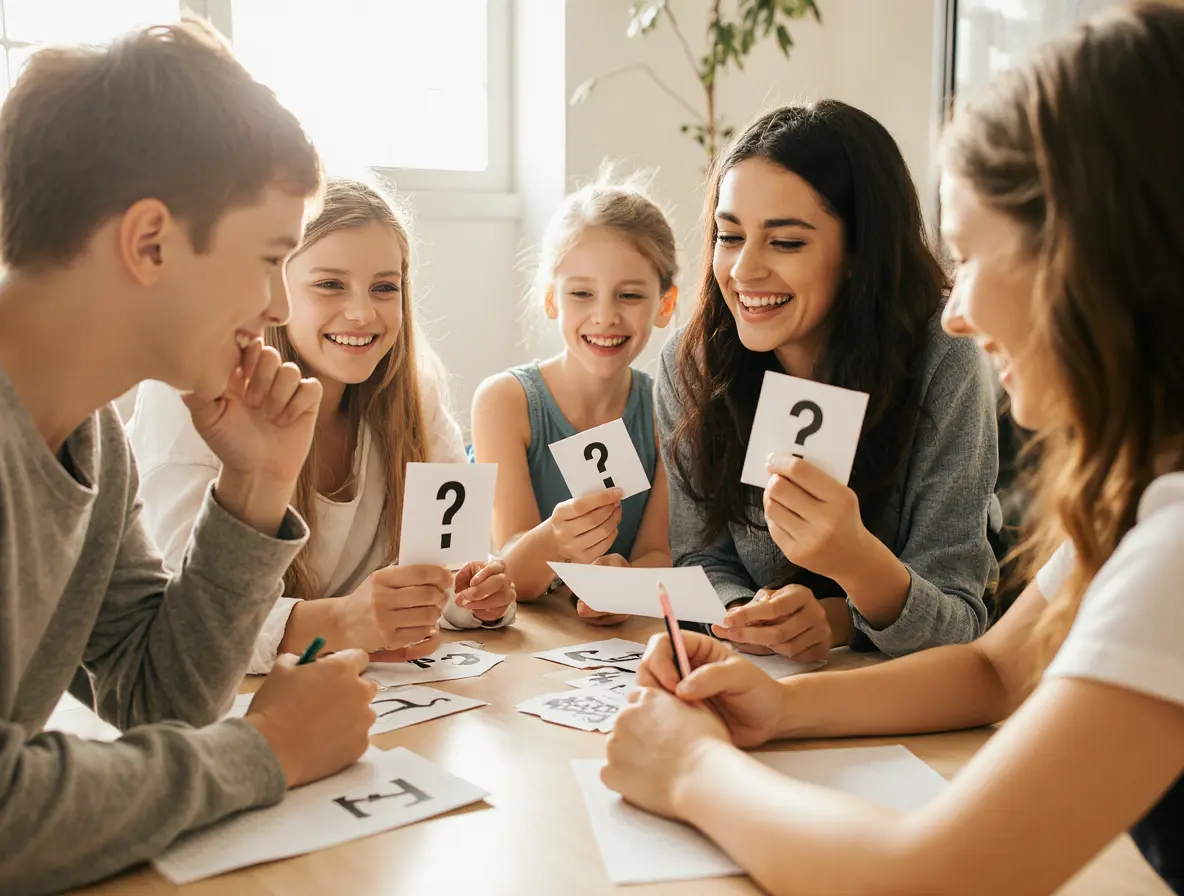Why Kids Riddles Are More Than Just Fun
What has words but never speaks?
A riddle. And guess what? Kids love them.
Riddles for kids aren’t just a way to pass the time on car rides or rainy days—they’re mini mental workouts wrapped in fun. These playful puzzles help children develop critical thinking, boost vocabulary, and learn problem-solving skills without even realizing it.
Think of riddles like the broccoli hidden in mac and cheese—delicious on the outside, secretly nutritious on the inside.
So whether you’re a parent, teacher, or just someone who enjoys a good brain teaser, you’re in for a treat. Let’s explore the wonderful world of kids riddles and see how laughter and learning go hand in hand.
Table of Contents
The Magic of Riddles: Why Kids Love Them
Riddles tap into something special in a child’s mind: curiosity.
Kids are naturally drawn to challenges that feel like games. Riddles ask them to pause, think differently, and then feel the rush of satisfaction when they crack the code.
Ever seen a kid’s face light up after solving a tricky riddle? It’s like unlocking a treasure chest with their brain.
But the benefits go deeper:
- Critical thinking: Riddles encourage logical reasoning and abstract thinking.
- Language development: Kids learn to understand wordplay and nuances in meaning.
- Memory boost: Repeating and solving riddles builds recall skills.
- Confidence builder: Cracking a tough riddle gives a huge confidence boost.
It’s no wonder riddles have been part of storytelling for centuries—from ancient fables to modern cartoons.
Classic Riddles Every Kid Should Know
Some riddles are so timeless, they’ve been shared for generations. These classic brain teasers are simple enough for kids to understand but clever enough to keep them guessing.
Here are a few beloved favorites:
Q: What has hands but can’t clap?
A: A clock.
Q: What has a head, a tail, but no body?
A: A coin.
Q: What gets wetter the more it dries?
A: A towel.
Why are these so enduring? Because they blend wordplay with real-world knowledge. A child can imagine, guess, and be surprised all in one sentence. That “aha!” moment is priceless.
Just like nursery rhymes or fairy tales, these riddles become part of childhood lore—passed from friend to friend on the playground.
Age-Appropriate Riddles: Making Sure the Fun Fits
Not all riddles are created equal—especially when it comes to age. A five-year-old might be stumped by something a ten-year-old finds easy.
So how do you choose the right riddles? Here’s a quick guide:
For ages 4–6:
Stick to visual or object-based riddles with simple vocabulary.
Q: What has four legs but can’t walk?
A: A table.
Q: What color is the sky?
A: A trick question when followed by a silly twist like “Only when the zebra forgets to wear blue!”
It’s not about being tricky—it’s about being playful.
For ages 7–9:
Introduce riddles that require a bit more logic or wordplay.
Q: I’m tall when I’m young, and short when I’m old. What am I?
A: A candle.
For ages 10+:
Kids this age can handle puns, lateral thinking, and metaphorical riddles.
Q: The more you take, the more you leave behind. What am I?
A: Footsteps.
Tailoring riddles to age makes them more rewarding and less frustrating.
The Learning Benefits of Solving Riddles
Beyond just being fun, kids riddles support cognitive and emotional development.
Here’s how:
1. Improves Comprehension and Language Skills
Riddles help kids learn about synonyms, antonyms, homophones, and metaphors—without the boring grammar drills. When a riddle says “What has a neck but no head?” they start thinking differently about what “neck” could mean (A: A bottle!).
2. Fosters Creative Thinking
Unlike math problems with one right answer, riddles often have multiple interpretations. That’s a great workout for the creative brain.
3. Encourages Patience and Focus
Riddles aren’t always solved instantly. Kids learn to pause, reflect, and try again—skills that translate to real-world learning and resilience.
4. Promotes Bonding and Conversation
Whether it’s between parent and child, teacher and student, or friends at lunch, riddles spark dialogue. It’s a language game that connects people.

As Dr. Amanda Wilks, a child psychologist, once said:
“Riddles are like little cognitive adventures. They train kids to think flexibly and adaptively while having fun.”
Fun Riddle Games and Activities for Kids
Want to make riddles even more engaging? Turn them into games! Here are some fun ideas:
Riddle Hunt
Hide objects around the house or classroom and leave a riddle clue at each stop. Kids solve the riddle to find the next clue. Think of it like a treasure hunt with brain teasers!
Example:
Clue: I have keys but no locks. I have space but no room. You can enter, but you can’t go outside. What am I?
(A: A keyboard—where the next clue is taped under.)
Riddle of the Day
Post a riddle each morning on the fridge or whiteboard. Let your kids guess throughout the day—maybe the winner gets to pick dinner!
Riddle Relay
In a group setting, each child gets a different riddle. They “pass the baton” (or next riddle) when they solve theirs. This encourages collaboration and peer learning.
Gamifying riddles makes them not just fun, but unforgettable.
Holiday and Seasonal Riddles for Extra Festive Fun
Riddles get even more fun when they match the season or special occasion. Here are a few to try out during holidays:
Halloween:
Q: I fly without wings, I cry without eyes. Whenever I go, darkness flies. What am I?
A: A bat.
Christmas:
Q: I come with many colors, so beautiful and bright. I turn so many houses into a beautiful sight. What am I?
A: Christmas lights.
Summer:
Q: You see me once in June, twice in November, but not at all in May. What am I?
A: The letter “e.”
Using themed riddles adds excitement to any celebration or learning plan.
Creating Your Own Riddles: A Fun Family or Classroom Project
You don’t need to be a poet or puzzle master to create great riddles. In fact, making them can be even more rewarding than solving them!
Here’s a simple formula to follow:
1. Pick a familiar object.
Something kids know, like a pencil, sun, dog, or backpack.
2. List what it does or looks like.
Ask: What’s unique about it? Can it do something funny or unexpected?
3. Use metaphor or playful language.
Instead of saying “I write,” try “I leave marks wherever I go, but I’m not a footprint.”
Here’s one we made with a group of 2nd graders:
Q: I have stripes but no shirt, I buzz but have no phone. What am I?
A: A bee!
Encouraging kids to create their own riddles builds confidence, imagination, and writing skills.
A Giant List of 20 Kids Riddles to Try Today
Here’s the part you’ve been waiting for—our ultimate collection of kids riddles! These cover a wide age range and themes to keep little minds buzzing.
- What has a face and two hands but no arms or legs?
A clock. - I go up but never come down. What am I?
Your age. - What has one eye but can’t see?
A needle. - I’m full of holes but still hold water. What am I?
A sponge. - What begins with T, ends with T, and has T in it?
A teapot. - What kind of band never plays music?
A rubber band. - What has a neck but no head?
A bottle. - I fly without wings. I cry without eyes. What am I?
A cloud. - What gets bigger the more you take away from it?
A hole. - I speak without a mouth. I echo without a voice. What am I?
An echo. - What comes down but never goes up?
Rain. - I’m not alive, but I grow. What am I?
Crystals or fire. - What travels around the world while staying in one spot?
A stamp. - I have keys but no locks. I have a space but no room. What am I?
A keyboard. - I’m tall when I’m young and short when I’m old.
A candle. - What is as light as a feather, yet the strongest person can’t hold it for long?
Your breath. - The more you take, the more you leave behind.
Footsteps. - What has four legs in the morning, two in the afternoon, and three in the evening?
A human (from riddle of the Sphinx). - What has a bottom at the top?
Your legs. - I run but never walk. I have a bed but never sleep. What am I?
A river.
Conclusion: Let Riddles Be Your Secret Learning Weapon
In a world full of screens and constant stimulation, riddles offer a gentle yet powerful alternative. They’re not just amusing—they’re smart fun.

With riddles, kids learn without pressure, grow their minds while they giggle, and build bonds through shared curiosity.
So next time your child asks for screen time, ask them a riddle instead. You might just start a new favorite tradition.
FAQs About Kids Riddles
1. What age is best to introduce riddles to children?
Kids as young as 4 can enjoy simple riddles. Start with object-based or rhyming riddles and gradually increase difficulty as they grow.
2. How often should I use riddles in the classroom or at home?
Even one riddle a day can improve critical thinking and communication skills. Riddle routines work great as warm-ups or brain breaks.
3. Are riddles educational or just for fun?
They’re both! Riddles improve language skills, memory, problem-solving, and social interaction—all while being playful.
4. Can riddles help shy kids open up?
Absolutely. Riddles invite participation in a low-pressure, humorous way. They’re great conversation starters and confidence boosters.
5. Where can I find new riddles regularly?
Try kid-friendly books, educational websites, and even make your own. Creating riddles together is part of the fun!

